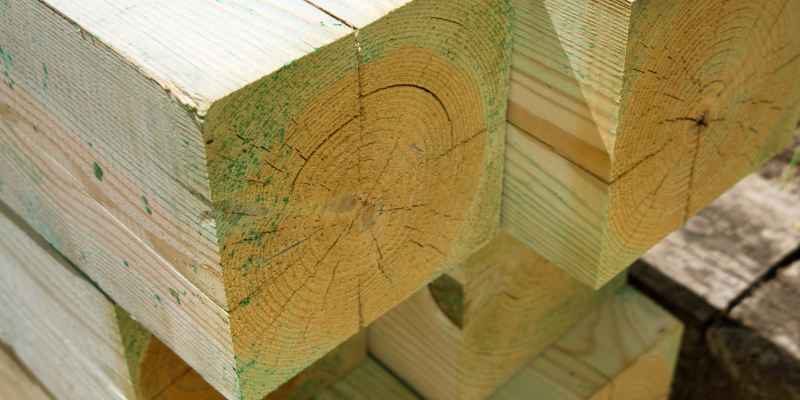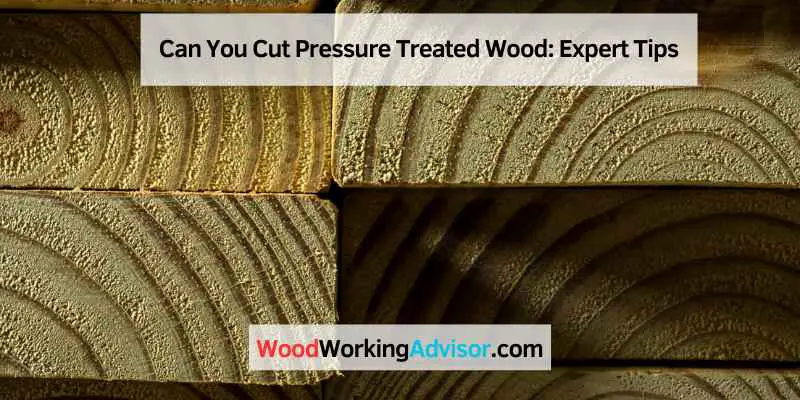Yes, you can cut pressure treated wood. However, it is important to take safety precautions such as wearing proper protective equipment and working in a well-ventilated area to minimize exposure to toxins.
Overview
When it comes to cutting pressure treated wood, it’s important to follow safe handling practices and wear protective equipment. Additionally, coating cut ends with an acceptable preservative can help protect the wood from rot.
Cutting pressure treated wood is a common task when working on various outdoor projects. However, it is important to understand the key aspects and safety measures involved in this process. In this article, we will provide an overview of cutting pressure treated wood, its safety considerations, and the recommended techniques to ensure the longevity of the wood.
Key Aspects
When it comes to cutting pressure treated wood, there are a few key aspects to keep in mind.
Safe Handling Practices
To ensure safety while cutting pressure treated wood, it is important to follow some safe handling practices. It is recommended to wear a dust mask and goggles to protect yourself from harmful particles. Additionally, wearing gloves and washing hands thoroughly with mild soap and water after working with treated wood can help minimize any potential risks.
Protecting Against Rot
One important aspect to consider when cutting pressure treated wood is protecting against rot. While pressure treated wood is inherently resistant to rot, any cuts or exposed areas can provide entry points for moisture and eventually lead to rot. Therefore, it is vital to apply a suitable preservative to the cut ends of the wood. Options such as Copper Naphthenate or Oxine Copper-based preservatives can effectively protect against rot.
Choosing The Right Cutting Technique
Using the right cutting technique is essential when working with pressure treated wood. When making cuts, it is recommended to use a saw with a carbide blade specifically designed for cutting treated wood. This type of blade is durable and will provide clean cuts without damaging the wood’s treated surface.
Working In A Well-ventilated Area
When cutting pressure treated wood, it is advisable to work in a well-ventilated area. This helps to minimize exposure to any toxins or chemicals that may be present in the wood. By ensuring proper ventilation, you can create a safer working environment for yourself.
Cleaning And Storing
After cutting pressure treated wood, it is important to clean the working area and store any leftover wood properly. Cleaning up any wood particles and debris will help maintain the cleanliness and safety of your workspace. Storing the leftover wood in a dry and well-ventilated area will prevent it from absorbing moisture and potentially causing damage or warping.
In conclusion, cutting pressure treated wood can be done safely and effectively by following these key aspects. By adhering to safe handling practices, protecting against rot, choosing the right cutting technique, working in a well-ventilated area, and properly cleaning and storing the wood, you can ensure the longevity and quality of your outdoor projects. Remember to prioritize safety and take the necessary precautions when working with pressure treated wood.
Understanding Pressure Treated Wood
Pressure treated wood, commonly used in outdoor construction projects, undergoes a chemical treatment process that enhances its durability and prevents decay. Understanding the properties and purpose of the treatment is crucial when working with pressure treated wood.
Properties Of Pressure Treated Wood
Pressure treated wood is infused with preservatives such as copper azole or alkaline copper quaternary, enhancing its resistance to decay, termite attacks, and fungal growth. The treatment process involves placing the wood in a pressure chamber, allowing the preservatives to penetrate deeply, thus preserving the wood from within.
Purpose Of Treatment
The primary purpose of treating wood is to extend its service life when exposed to harsh environmental conditions. This treatment ensures that pressure treated wood can withstand moisture, soil contact, and other elements that typically lead to decay in untreated wood.
Importance Of Cutting Pressure Treated Wood Safely
Safely cutting pressure-treated wood is crucial for preventing rot and maintaining its longevity. Use proper protective gear like gloves, goggles, and a dust mask to shield yourself from harmful particles. Always seal cut ends with a suitable preservative to protect the wood from moisture and decay.
Preservation Of Wood Integrity
When you’re considering cutting pressure treated wood, it’s crucial to prioritize the preservation of the wood’s integrity. Pressure-treated wood is infused with preservatives to protect it from rot, decay, and pests. Therefore, cutting it improperly can compromise its integrity and leave it vulnerable to these threats.
Avoiding Health Risks
Another critical aspect of cutting pressure treated wood safely is to avoid potential health risks. The preservatives in pressure-treated wood, such as chromated copper arsenate (CCA), can pose health hazards if inhaled or ingested. Safe handling practices, including wearing protective equipment like a dust mask and goggles, can help minimize the risk of exposure to harmful particles.

Safety Measures For Cutting Pressure Treated Wood
When cutting pressure-treated wood, be sure to wear protective gear like gloves, goggles, and a dust mask. Wash hands and work clothes thoroughly post-handling. Seal the cut ends with a suitable preservative to maintain the wood’s integrity and durability.
Recommended Protective Gear
When cutting pressure treated wood, it is crucial to wear the appropriate protective gear to ensure your safety and minimize potential health risks. This includes:
- A dust mask: Helps prevent inhalation of harmful particles and sawdust.
- Goggles: Protects your eyes from any wood debris or flying particles.
- Gloves: Shields your hands from coming into direct contact with the treated wood.
By wearing this recommended protective gear, you can effectively safeguard yourself from any potential hazards associated with working with pressure treated wood.
Proper Handling And Cleanup
In addition to wearing protective gear, proper handling and cleanup practices are essential when cutting pressure treated wood. Follow these guidelines:
- Always handle the wood with gloves to protect your skin from potential chemical exposure.
- After working with treated wood, wash your hands thoroughly with mild soap and water.
- It is important to wash your work clothes separately from your regular clothes to avoid any cross-contamination.
By following proper handling procedures and practicing good hygiene, you can minimize any potential health risks associated with working with pressure treated wood.
Remember: Safety should always be the top priority when working with pressure treated wood. By wearing the recommended protective gear and following proper handling and cleanup practices, you can ensure a safer and healthier working environment for yourself.
Methods To Safely Cut Pressure Treated Wood
When working with pressure treated wood, it’s crucial to employ the right techniques to ensure safe and precise cuts. Below are some methods for safely cutting pressure treated wood:
Using The Right Tools
- Use a circular saw or miter saw: Opt for a saw with a carbide-tipped blade designed for cutting pressure treated wood.
- Wear appropriate safety gear: Always wear safety goggles, gloves, and a dust mask to protect yourself from harmful particles.
- Select the correct blade: Choose a blade with more teeth for cleaner cuts.
Techniques For Clean Cuts
- Measure and mark: Accurately measure and mark the area you intend to cut to avoid errors.
- Support the wood: Use sawhorses or a stable work surface to support the wood while cutting.
- Cut slowly and steadily: Avoid rushing the cutting process to ensure precision and safety.
- Seal cut ends: After cutting, apply a suitable preservative such as Cut-N-Seal® to protect the exposed ends from moisture and rot.
Post-cutting Care For Pressure Treated Wood
When cutting pressure treated wood, it is crucial to provide proper care to maintain its durability and longevity. Post-cutting care involves sealing cut ends and applying protective coatings to safeguard the wood from environmental factors. Follow these guidelines to preserve the integrity of pressure treated wood after cutting:
Sealing Cut Ends
Sealing the cut ends of pressure treated wood is essential to prevent moisture infiltration and prolong its lifespan. After cutting the wood, apply a suitable sealant to the exposed ends to create a barrier against water penetration. This step helps minimize the risk of decay and ensures the wood remains structurally sound over time.
Protective Coatings
Applying protective coatings is another vital step in caring for pressure treated wood post-cutting. These coatings act as a protective layer against UV rays, moisture, and other elements that can degrade the wood. Choose a high-quality coating specifically designed for pressure treated lumber to enhance its resilience and maintain its appearance.
Common Queries And Concerns
When it comes to working with pressure treated wood, many individuals have common queries and concerns about the process. It’s crucial to address these concerns to ensure safe and effective handling of the material. Some of the key concerns include the effect on saw blades, as well as the safety of the cutting process.
Effect On Saw Blades
When cutting pressure treated wood, it’s essential to consider the impact on saw blades. Due to the chemicals and moisture present in pressure treated wood, it can cause accelerated wear and corrosion on saw blades. It’s important to use blades specifically designed for cutting pressure treated wood to maintain their durability and effectiveness. Additionally, regular maintenance and cleaning of saw blades after use on pressure treated wood are necessary to prolong their lifespan and ensure optimal performance.
Safety Of The Process
Ensuring the safety of the cutting process is paramount when working with pressure treated wood. To safely cut pressure treated wood, appropriate personal protective equipment must be worn, including a dust mask, goggles, and gloves to minimize exposure to harmful particles and chemicals.
Additionally, cutting pressure treated wood in a well-ventilated area can help reduce the risk of inhalation and contact with toxins. Proper handling and disposal of sawdust and waste material from cutting pressure treated wood are also important safety considerations to prevent potential health hazards.
Frequently Asked Questions For Can You Cut Pressure Treated Wood
Will Pressure Treated Wood Rot If Cut?
Cutting pressure-treated wood does not make it more susceptible to rot. However, the cut edges may not have the same level of protection as the rest of the wood. It is important to apply an appropriate preservative or sealant to the cut ends to prevent moisture intrusion and potential rot.
Use proper safety measures when cutting pressure-treated wood, such as wearing a dust mask, goggles, and gloves.
How Do You Safely Cut Pressure Treated Wood?
When cutting pressure treated wood, wear protective gear like a dust mask, gloves, and goggles. Work in a well-ventilated area. Wash hands and clothes after handling. Treat cut ends with a water-based sealer like Cut-N-Seal to protect against moisture. Avoid exposing untreated areas.
Is Pressure Treated Wood Harder To Cut?
Yes, pressure-treated wood is harder to cut due to the preservative treatment. The chemicals can dull blades quicker.
What Is Recommended When Cutting Pressure-treated Lumber?
When cutting pressure-treated lumber, it is recommended to wear protective gear such as a dust mask and goggles to avoid inhaling harmful particles. It is also advised to cut the wood outdoors in a well-ventilated area to minimize exposure to toxins.
Additionally, coating cut ends with an acceptable preservative can protect the wood from rot and decay.
Conclusion
While it is possible to cut pressure-treated wood, it is important to take certain precautions. When cutting pressure-treated wood, it is recommended to wear appropriate protective equipment like a dust mask and goggles to avoid inhaling harmful particles. It is also important to coat any cuts, holes, or abrasions with an acceptable preservative to protect the wood from rot.
Cutting pressure-treated wood outdoors in a well-ventilated area can help minimize exposure to toxins. Overall, with the right safety measures, cutting pressure-treated wood can be done effectively and safely.


